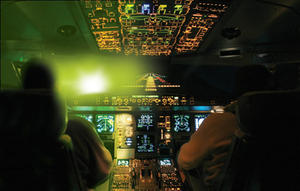Aviation securityPointing lasers at aircraft a growing problem
According to the FBI, in 2008 there were approximately 1,000 instances of people aiming laser pointers at the pilots of aircraft; in the eight month period from January to August of 2010, there were 1,700 reported incidents, demonstrating an increasing trend in the cases; the light emitted by a laser pointer can then be directed toward and seen by a pilot, causing visual impairment such as glare on the windshield of the aircraft as well as flash blindness and after-images like the kind that can be experienced after a flash picture is taken; even if the beam does not hit the pilot directly causing temporary blindness, the beam can be distracting at times when distractions can be deadly

Cockpit-view of effect of lasering // Source: gc.ca
The lasering of aircraft has become a problem in the United States in recent years, potentially endangering many lives on both commercial and private aircraft as well as those on the ground. According to the FBI, in 2008 there were approximately 1,000 instances of people aiming laser pointers at the pilots of aircraft, the majority of those instances occurring during critical points in the flight such as takeoff and landing, when the potential for disaster is at its highest and the pilot’s full concentration is needed. In the eight month period from January to August of 2010, there were 1,700 reported incidents, demonstrating an increasing trend in the cases.
The danger of the “prank” lies in the ability of the laser light to travel great distances with high energy while maintaining a very high level of cohesion. In other words, the laser light will remain as a small point through great distances as compared to a flashlight, where the light starts at a single point and fans out into a cone as distance from the source increases. This concentrates the energy of the laser onto that single point. The light emitted by a laser pointer can then be directed toward and seen by a pilot, causing visual impairments such as glare on the windshield of the aircraft as well as flash blindness and after-images like the kind that can be experienced after a flash picture is taken. Even if the beam does not hit the pilot directly causing temporary blindness, the beam can be distracting at times when distractions can be deadly.
Some question the assertion that laser pointers are dangerous to pilots. Dr. Glenn Chapman, a professor of Engineering Science at Simon Fraser University, dismisses the ability of hand held laser pointers to do damage to the eyes of pilots or cause blindness due to the distances involved. At less than 300 feet, he claims, the light could do damage, but with planes flying at altitudes of over a mile, the power of the beam would be greatly diminished. He also points to the accuracy one must have to aim the point at a pilot’s eyes at such distances. Acknowledging that pilots have experienced temporary blindness from lasers during laser shows, Chapman points to the fact that those lasers are much more powerful than a handheld laser pointer. He does caution, however, that the hand held laser pointers can be distracting and should not be aimed at aircraft.
Despite the recent attention in the news, the prank is not an original invention but has in fact been used for over seventy years by militaries. During the Second World War, large searchlights that were bright enough to cause permanent or temporary blindness were used to thwart the crews of bombers. During the Falklands War between Great Britain and Argentina, the Royal Navy made use of the first laser dazzlers in combat to stop Argentinean air attacks, using the lasers to blind the pilots. The U.S. Armed Forces have also developed advanced laser dazzler systems as have many local law enforcement agencies for less than lethal deployment in the field, using the same principles of a flash bang. These lasers all have power much higher than can be found in a hand held laser pointer.
Luckily, it is a federal offense to interfere with the safe operation of an aircraft, an offense that carries a maximum sentence of twenty years in prison. Terrorism charges can also be brought against people accused of attempting to crash an airplane. When asked why so much attention was paid to the issue of lasering aircraft, Dr. Chapman responds “Maybe they are trying to get terrorists to use laser pointers this way so it is easy to find them.”
